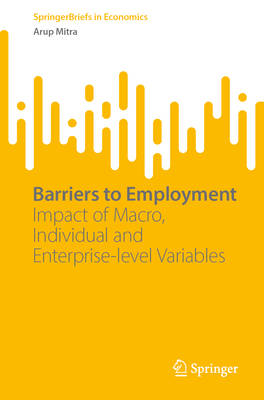
- Afhalen na 1 uur in een winkel met voorraad
- Gratis thuislevering in België vanaf € 30
- Ruim aanbod met 7 miljoen producten
- Afhalen na 1 uur in een winkel met voorraad
- Gratis thuislevering in België vanaf € 30
- Ruim aanbod met 7 miljoen producten
Omschrijving
This book uses the state-level panel data to identify some of the important correlates of employment growth/elasticity and indicators of quality-employment. To do so, it considers a wide spectrum of variables including physical, financial and social infrastructure specific indicators and government spending in certain key areas. In addition to the aggregate employment, the book also comprises analysis of different sectors, regions and gender categories. Based on the results, it identifies crucial determinants which bear important policy implications.
The book presents evidence showcasing how the overall investment climate and an effective state, as envisaged in terms of increased social expenditure, are instrumental to improvements in employment elasticity. The findings also reinforce the role of industry-led growth and agglomeration economies in contributing to employment growth. Besides, based on the unit-level data from the periodic labour force surveys, the book tries to answer a wide range of questions such as, what restricts a person from getting absorbed in a high productivity activity; within a given sector why one is in a casual or self-employed job and not in regular wage job; are casual wage jobs in the informal sector different from those in the formal sector; and why the wage variations exist across sectors and activities. The three rounds of periodic labour force surveys reflect on certain individual and household characteristics; in particular, the role of education is seen to be crucial in determining the occupational choice and the wage rate. Finally, the book focuses on the enterprise-level data and identifies the types of units which are vulnerable within the unorganized sector. It assesses the links of the unorganized sector units with their organised sector counterpart and identifies the factors which reduce the economic viability of the units.
Specificaties
Betrokkenen
- Auteur(s):
- Uitgeverij:
Inhoud
- Aantal bladzijden:
- 109
- Taal:
- Engels
- Reeks:
Eigenschappen
- Productcode (EAN):
- 9789819945696
- Verschijningsdatum:
- 5/08/2023
- Uitvoering:
- Paperback
- Formaat:
- Trade paperback (VS)
- Afmetingen:
- 156 mm x 234 mm
- Gewicht:
- 176 g

Alleen bij Standaard Boekhandel
Beoordelingen
We publiceren alleen reviews die voldoen aan de voorwaarden voor reviews. Bekijk onze voorwaarden voor reviews.











